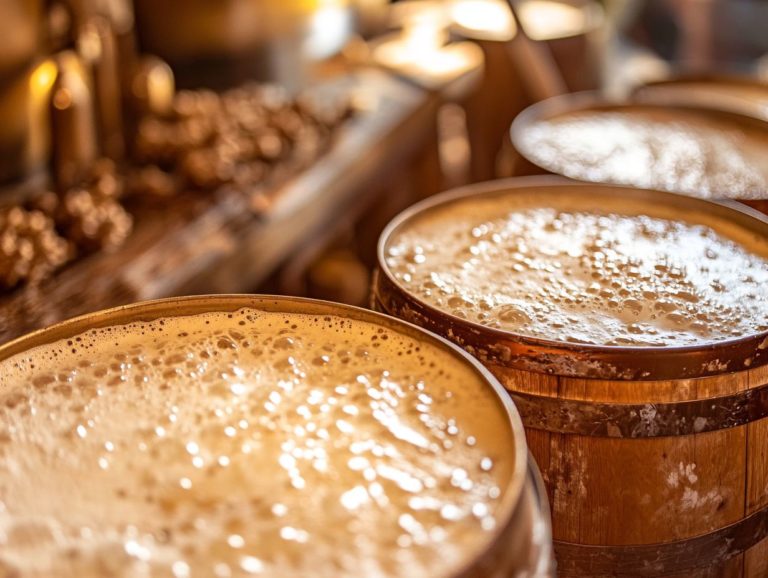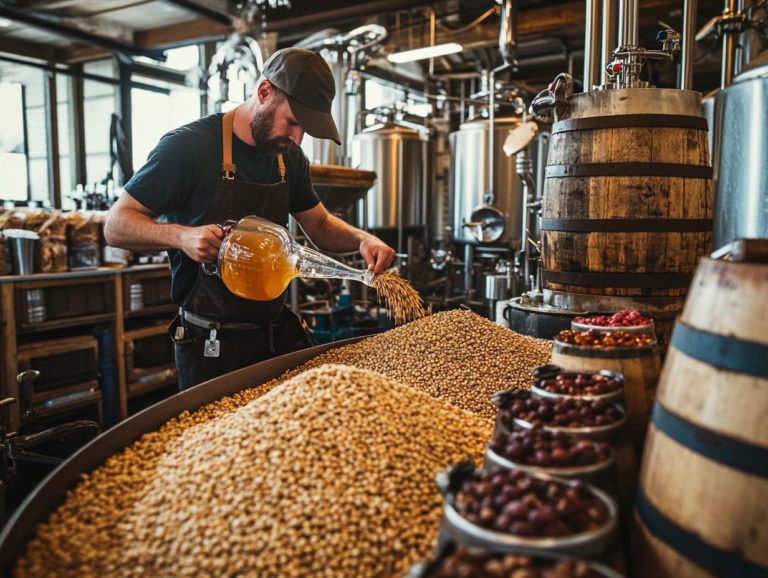5 Essential Fermentation Tools for Home Brewing
Fermentation is a fascinating process that transforms simple ingredients into delightful beverages, serving as a cornerstone of home brewing.
Regardless of whether you re just starting out or have years of brewing experience under your belt, having the right tools at your disposal can greatly enhance both your brewing journey and the quality of your creations.
This article delves into five essential fermentation tools: glass jars, airlocks, thermometers, strainers, and pH meters. We will also explore the importance of having a fermentation bucket, gallon pot, and other essential equipment to support your homebrewing journey.
Discover how each tool plays a vital role in the fermentation process and gain insights on selecting the best options to elevate your home brewing skills. Whether it’s for brewing beer, kombucha, sauerkraut, or pickles, the right equipment makes all the difference.
Contents
- Key Takeaways:
- 1. Glass Fermentation Jars
- 2. Airlocks and Lids
- 3. Thermometer
- 4. Strainer or Cheesecloth
- 5. pH Strips or Meter
- What Is Fermentation and Why Is It Important in Home Brewing?
- What Are the Different Methods of Fermentation?
- How Do These Tools Aid in the Fermentation and Brewing Process?
- What Are the Different Types of Glass Fermentation Jars and Fermentation Crocks?
- What Should One Look for When Choosing an Airlock and Lid for a Fermentation Bucket?
- How Can a Thermometer Help in the Fermentation and Brewing Process?
- Frequently Asked Questions
- Home Brewing Essentials
Key Takeaways:
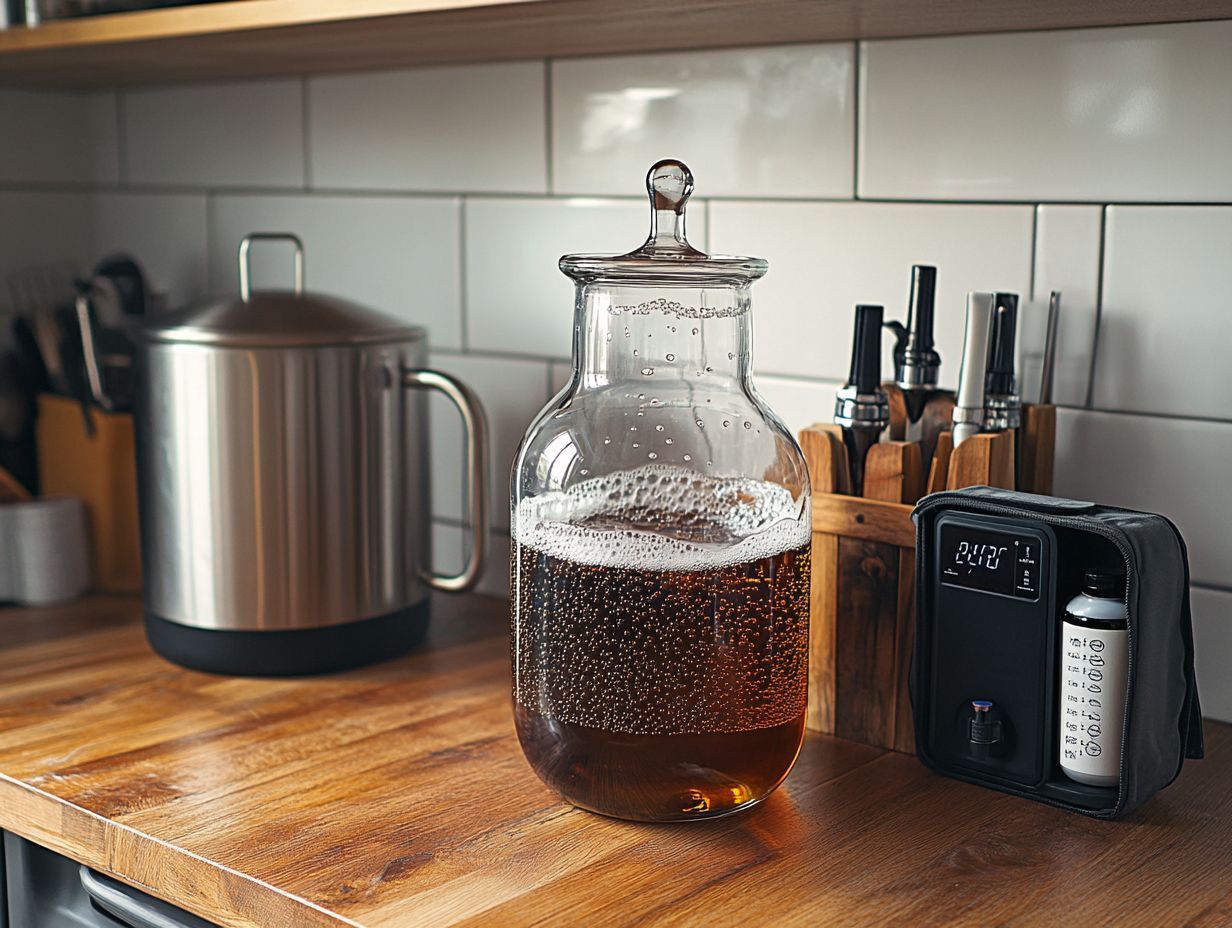
- Invest in quality glass fermentation jars to ensure a safe and efficient fermentation process.
- Airlocks and lids are essential to prevent contamination and allow for proper gas release during fermentation.
- Monitoring the temperature with a thermometer is crucial for successful fermentation and achieving desired flavors.
- Having a hydrometer (a tool that measures the specific gravity of liquids) and sanitizer on hand ensures your process remains precise and sanitary.
1. Glass Fermentation Jars
Glass fermentation jars are essential for any serious homebrewer. They allow for meticulous monitoring of the fermentation process, ensuring that all your essential ingredients grain, hops, and yeast are contained during this crucial stage of brewing beer.
The transparency of glass lets you observe the fermentation activity in real-time, making it easier to spot any potential issues while also adding a touch of aesthetic enjoyment to your brewing journey. With the right size and shape, these jars can facilitate proper fermentation, leading to successful outcomes for your beer recipes.
Opting for glass over plastic fermentation jars comes with a host of advantages that can significantly elevate your brewing experience. For one, glass boasts remarkable durability and non-reactive properties. This means the flavors of your carefully selected ingredients remain pure and untouched by any chemical leaching that can sometimes plague plastic containers.
Glass jars also work beautifully with essential fermentation equipment like weights and airlocks, creating an airtight environment that fosters optimal fermentation conditions. Industry experts, including Joe Postma and the team at Serious Eats, consistently advocate for glass fermentation jars due to their reliability and effectiveness. Investing in glass jars is crucial for homebrewers seeking great results. If you’re brewing larger batches, consider using a fermentation crock. An aluminum lobster pot is perfect for boiling your wort.
2. Airlocks and Lids
Airlocks and lids are essential players in your home brewing journey, expertly regulating the fermentation environment. They allow carbon dioxide to escape while keeping contaminants at bay, ensuring the ideal temperature and atmosphere for your yeast to thrive.
You ll find a variety of airlock types at your disposal, including S-shaped, bubbler, and three-piece models, each designed to operate in its own unique fashion. For example, S-shaped airlocks tend to provide a more efficient gas release, while bubbler styles can be quite appealing for their visual cues indicating fermentation activity. Investing in a fermentation bucket with a good seal and an airlock will help maintain ideal conditions for your brew.
Your choice of airlock may hinge on the specific brewing process you re utilizing, influencing how effectively they seal and maintain sanitation. It’s vital to keep these components clean and well-maintained; any oversight could lead to spoilage, undermining all your hard work. Utilizing sanitizer regularly helps keep your airlocks in top condition.
By regularly disassembling and sanitizing your airlocks, along with inspecting for cracks or leaks, you ensure they perform at their best, giving you the power to achieve the finest results in your brewing endeavors. Remember, a wort chiller can also be an invaluable tool in cooling your brew efficiently before fermentation starts.
Ready to elevate your home brewing experience? Start your brewing journey today with the right tools!
3. Thermometer
A thermometer is an essential tool in your homebrewing arsenal, ensuring that the fermentation temperature stays within the ideal range for yeast activity. Paying close attention to temperature is key, as it directly influences the quality and flavor of your beer.
Selecting the right type of thermometer is vital for achieving consistent results. You may find that digital thermometers are particularly appealing due to their speed and accuracy. They allow you to check liquid temperatures swiftly without significant fluctuations. Conversely, analog thermometers can lend a classic charm to your brewing process and can be quite reliable if calibrated properly.
Keep a close eye on the temperature to ensure your beer turns out great! Any fluctuations can impede yeast performance and potentially introduce off-flavors into your finished product.
To create the perfect environment for fermentation, consider investing in temperature-controlled fermentation chambers or insulating your fermentation vessel. This way, you can minimize temperature swings and maintain a stable climate that promotes optimal yeast activity.
4. Strainer or Cheesecloth
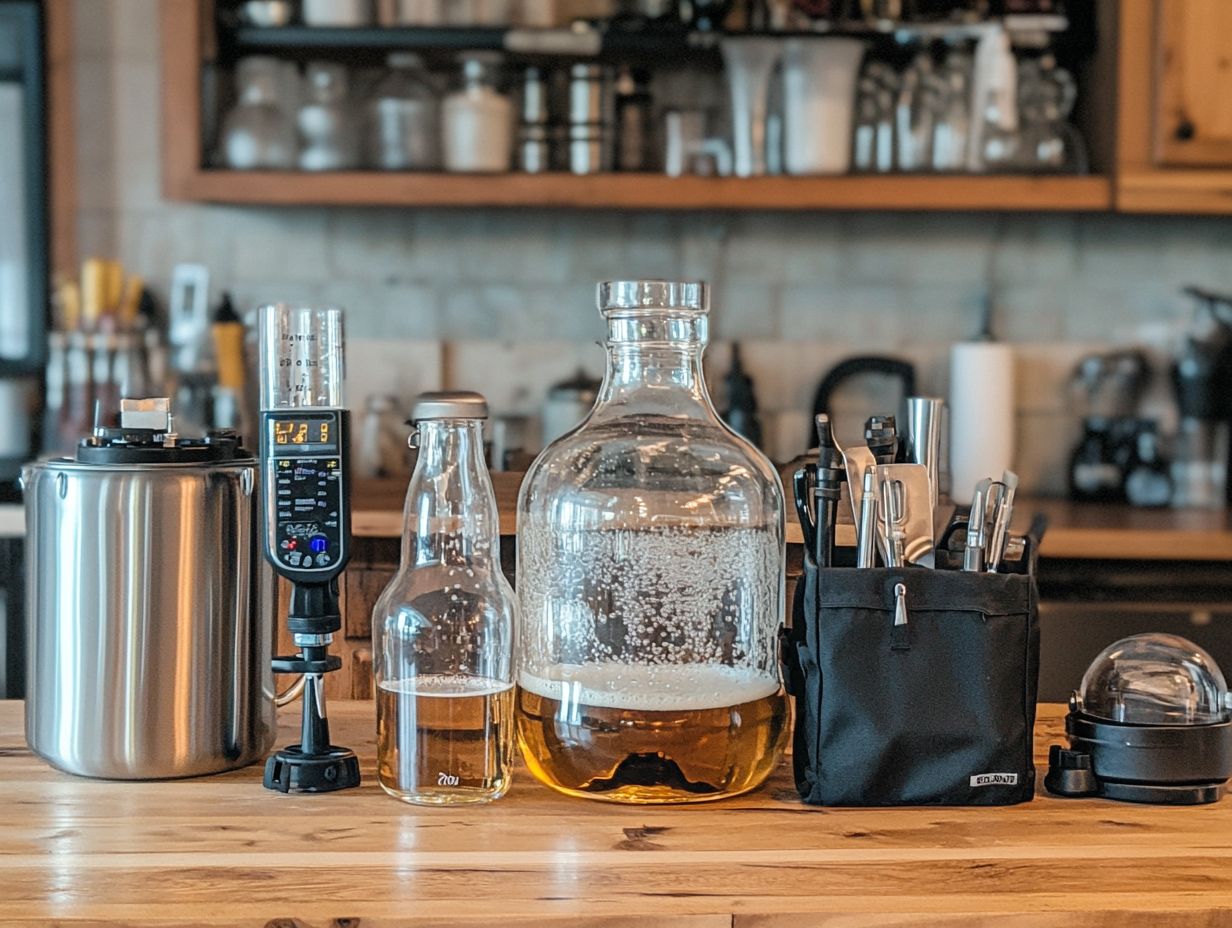
Using a strainer or cheesecloth is absolutely essential during the brewing process, particularly when it comes to separating the wort (the liquid extracted from the mashing process) from the grains after mashing. This crucial step ensures you end up with a clear liquid, which is vital for the final quality of your homebrew.
These tools are also significant beyond simple separation. Various types of strainers be it fine mesh, nylon, or stainless steel offer different levels of filtration. You can effectively remove not just the solid grain particles but also any pesky hop debris and other particulates that might cloud your brew.
Cheesecloth serves a dual purpose: it traps coarse materials effectively while also helping to steep grains for those who favor a more nuanced flavor profile. In the end, both strainers and cheesecloth elevate the clarity and texture of your final product, enabling you to craft a clean and crisp beer that truly showcases the quality of your selected ingredients.
5. pH Strips or Meter
Employing pH strips or a meter is crucial for you as a homebrewer who seeks to perfect the fermentation process. This tool enables precise measurement of acidity levels, a key factor that significantly influences the taste and quality of your beer.
Understanding the ideal pH range typically between 4.0 and 5.5 for most styles can lead to a more balanced flavor profile and enhance yeast performance. If your pH levels stray too high or too low, you risk introducing off-flavors or reducing fermentation efficiency, which could compromise the integrity of your final product.
Don’t forget to calibrate your pH meter regularly for the best results! Monitoring pH throughout fermentation is vital, particularly during the initial stages, as changes can arise from various factors like temperature and ingredients. By maintaining these levels, you not only clarify your brew but also elevate the overall drinking experience.
What Is Fermentation and Why Is It Important in Home Brewing?
Fermentation is an essential biological process in home brewing. It is where yeast transforms the sugars from malted grains into alcohol and carbon dioxide, ultimately resulting in the creation of beer.
Grasping this process is fundamental for anyone like you who aspires to craft flavorful and high-quality brews.
The journey of fermentation encompasses both primary and secondary phases. Each contributes uniquely to the drink’s overall development.
In the primary fermentation phase, yeast eagerly devours the sugars, generating alcohol and CO2. The secondary fermentation phase allows for the refinement of flavors and clarification of the brew.
Using a brewing kettle and wort (the liquid extracted from the malted grains) chiller can greatly improve the efficiency of your brewing process.
Temperature control is paramount in this process! Maintaining the ideal temperature range ensures that yeast operates efficiently, yielding the most desirable flavors.
Many novice brewers fall into common traps, such as fermenting at inappropriate temperatures or neglecting to adequately oxygenate the wort. Don’t let inappropriate temperatures ruin your batch!
By being mindful of these factors and looking into the subtleties of yeast behavior, you can significantly enhance your brewing outcomes and steer clear of disappointing batches.
Using ingredient kits can also simplify the process, ensuring you have the right components for a successful brew.
What Are the Different Methods of Fermentation?
In home brewing, you ll discover a variety of fermentation methods. Each employs different types of yeast and fermentation vessels that contribute distinct flavors and characteristics to your final beer.
Primary fermentation is where the magic begins, as yeast actively converts sugars into alcohol and carbon dioxide. This process is essential for establishing the foundational profile of your beer.
Once that s complete, you might consider secondary fermentation, which can enhance both clarity and flavor. It allows for richer complexities to emerge.
As you delve deeper into the brewing process, think about your fermentation choices. You could opt for open fermentation, inviting wild yeasts and bacteria to join the party. This results in intriguing and sometimes unpredictable flavors.
On the other hand, closed fermentation minimizes environmental exposure, giving you a cleaner finish. Using a plastic bucket for open fermentation can be a cost-effective option, while glass bottles are ideal for closed fermentation.
By skillfully manipulating fermentation techniques like controlling temperature and selecting various container types you ll be able to steer your brewing journey! This ultimately leads to a delightful array of beer styles and tastes.
A brewing kit can also be an excellent start for beginners, offering a comprehensive set of tools to get you going.
How Do These Tools Aid in the Fermentation and Brewing Process?
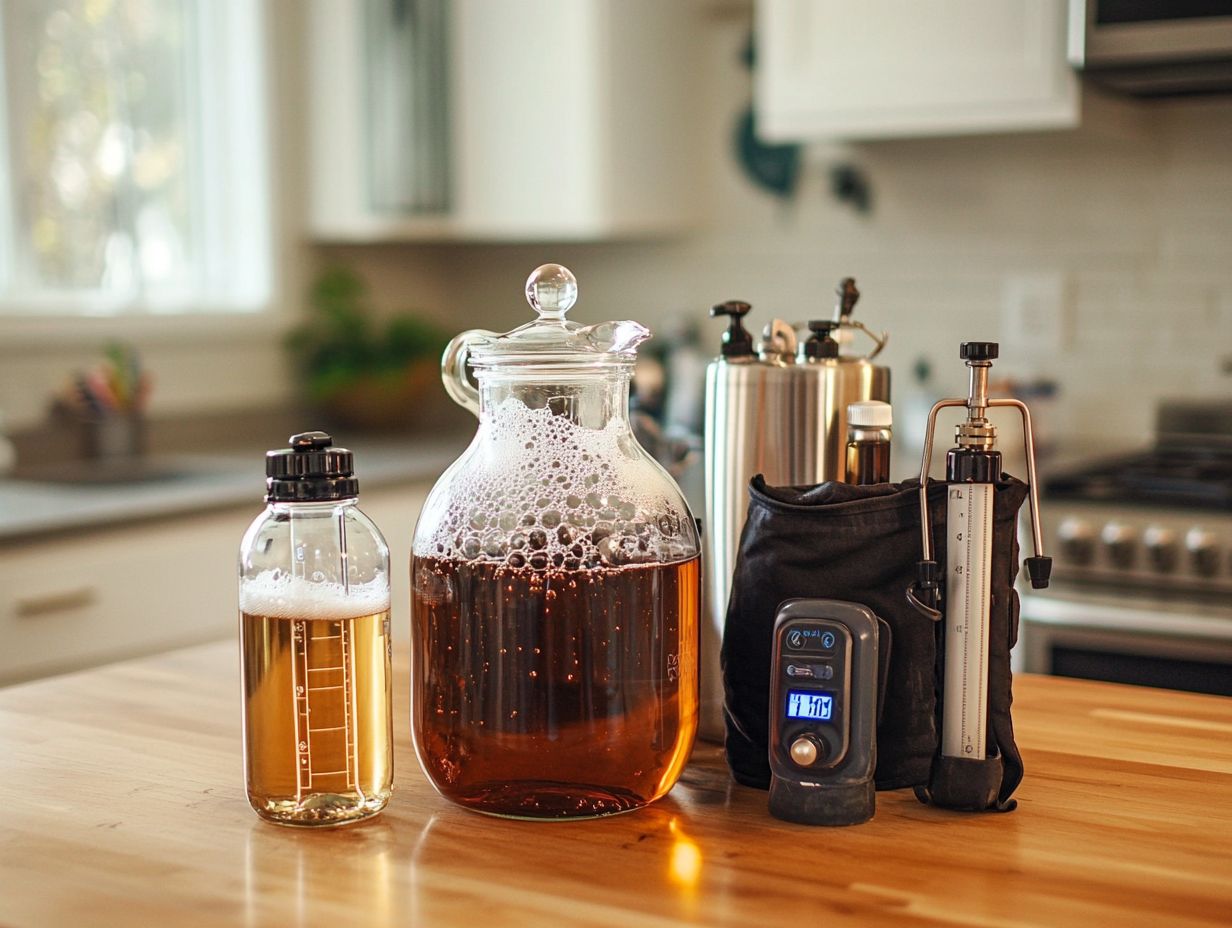
The right tools for fermentation think glass fermentation jars, airlocks, and temperature control devices are essential for ensuring that your fermentation process unfolds smoothly and yields high-quality beer.
Having a well-prepared homebrew setup and using ingredient kits can further enhance the quality and consistency of your brew.
Effective fermentation is a delicate balance, demanding careful monitoring of several key factors. These tools are pivotal in achieving that harmony.
Glass fermentation jars not only offer you a crystal-clear view of the bubbling activity inside but also maintain a sterile environment that guards against contamination.
Airlocks and fermentation weights play a crucial role! They allow carbon dioxide to escape while keeping external contaminants at bay, creating a safe haven for your yeast to thrive.
Meanwhile, temperature control devices ensure that the yeast remains within its optimal temperature range. This promotes healthy fermentation and wards off any off-flavors.
Using a wort chiller can also help quickly bring down the temperature of the wort to an ideal level, making it safe for the yeast to be added.
By utilizing these essential tools, you can cultivate the ideal conditions for yeast growth and fermentation! This ultimately enhances the quality of your final product.
Tools like a digital scale and pH strips are also important for measuring ingredients accurately and maintaining the right acid balance.
What Are the Different Types of Glass Fermentation Jars and Fermentation Crocks?
In terms of glass fermentation jars, you’ll find a variety tailored to homebrewers, each differing in size and shape to suit your specific brewing needs and preferences.
These vessels can range from compact one-gallon jars, perfect for your small-scale experiments, to larger six-gallon containers designed for more ambitious batches. You might also consider using a fermentation crock for making other fermented products like sauerkraut and pickles. As you select a jar, it’s crucial to consider the type of fermentation you’re undertaking whether primary or secondary as well as the characteristics of your ingredients and recipe.
For example, some jars feature wide mouths, making cleaning and adding ingredients a breeze. Others have narrow openings that reduce exposure to air. Look for specific features like airtight lids and airlocks; these can significantly enhance your fermentation process by regulating airflow, preventing oxidation, and ensuring a consistent brew. Proper cleaning and maintenance of your equipment are also essential to avoid bacteria contamination.
By understanding these attributes, you can choose the jar that will best support your brewing journey.
What Should One Look for When Choosing an Airlock and Lid for a Fermentation Bucket?
When choosing an airlock and lid for your fermentation bucket or plastic bucket, consider factors like design, material, and ease of use to achieve optimal performance during the fermentation process.
The choice between a three-piece and two-piece airlock can significantly influence your fermentation outcome; each style brings its own unique advantages. Use a sanitizer to clean your airlocks and lids to prevent bacteria contamination. A three-piece airlock offers greater versatility and ease of cleaning, allowing you to sanitize thoroughly and reduce the risk of off-flavors. In contrast, a two-piece design tends to be simpler and more compact, making it a fantastic option for smaller setups or when you re tight on space.
Evaluate how these designs can elevate your brewing experience! Ensuring compatibility means the fermentation process can proceed smoothly, ultimately leading to a successful brew. Selecting durable materials that can endure the fermentation environment enhances the longevity and reliability of your airlock setup.
How Can a Thermometer Help in the Fermentation and Brewing Process?
A thermometer is an essential tool in your fermentation journey. It enables you to monitor and maintain the optimal temperature range for yeast activity. This precision is crucial for crafting the desired flavor profiles in your beer or other fermented beverages like kombucha.
Understanding how temperature influences fermentation rates is essential for brewing success. Yeast thrives within specific temperature ranges, leading to more consistent and controlled fermentation. If temperatures rise too high, you risk accelerating fermentation, potentially resulting in off-flavors. Conversely, lower temperatures can slow down or even stall the process altogether.
The placement of your thermometer is equally important; it should be situated in the center of the fermentation vessel to ensure accurate internal readings. Regular calibration is a must to guarantee that your thermometer delivers reliable data. Even a slight deviation can significantly affect yeast performance and, ultimately, the quality of your final product.
Frequently Asked Questions
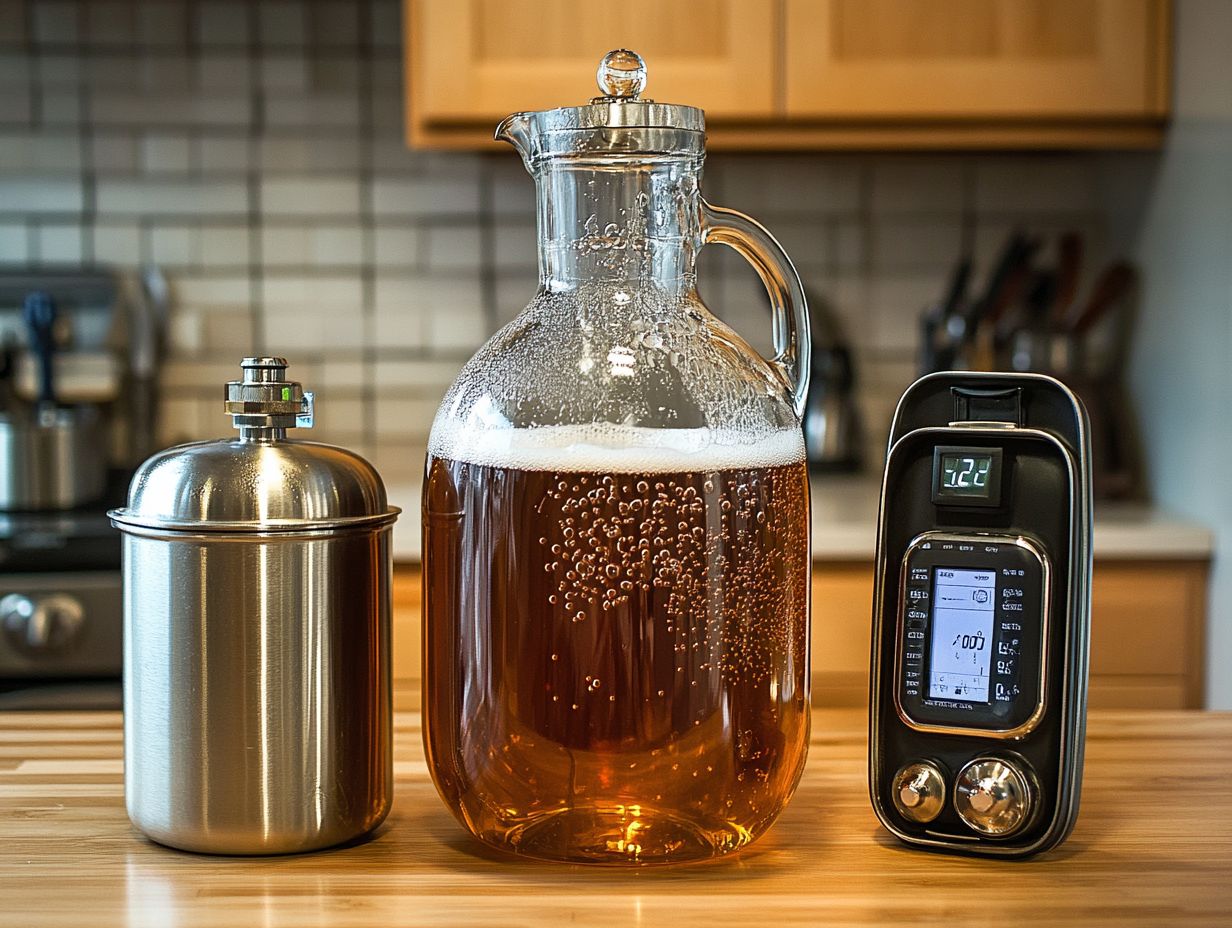
What are the 5 essential fermentation tools for home brewing?
The 5 essential fermentation tools for home brewing are a fermenter, an airlock and stopper, a hydrometer, a siphon, and a thermometer. Other helpful tools include a brewing kettle, bottling wand, and bottle caps.
Why do I need a fermenter for home brewing?
A fermenter is necessary for home brewing as it is where the fermentation process takes place. It is where the yeast converts the sugars in the wort the liquid extracted from the malted grains used in brewing into alcohol and carbon dioxide. Using a sturdy aluminum lobster pot or gallon pot can also be beneficial in brewing.
Home Brewing Essentials
What is the purpose of an airlock and stopper in fermentation?
An airlock and stopper seal the fermenter. They allow carbon dioxide to escape while preventing oxygen and contaminants from spoiling the beer’s flavor.
Why is a hydrometer important in home brewing?
A hydrometer measures the wort’s specific gravity before and after fermentation. This measurement tells you the alcohol content and the fermentation’s progress.
Using pH strips to monitor acidity levels can improve your brewing results!
What is the role of a siphon in fermentation?
A siphon transfers the fermented beer to a secondary vessel or bottles for carbonation. This method ensures a smooth transfer without disturbing the sediment at the bottom of the fermenter.
Don’t forget to use a bottle capper and glass bottles to seal your finished product!
Do I need a thermometer for home brewing?
Yes! A thermometer is crucial for monitoring the wort’s temperature during brewing. It helps maintain the ideal conditions for yeast activity during fermentation.
For those serious about brewing, investing in a complete brewing kit that includes all these tools is a smart choice!

